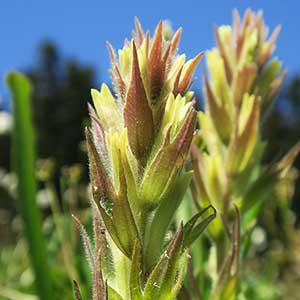Castilleja lineariloba
Castilleja cryptantha
pale owl-clover, thin-lobed owl's clover
Mt. Rainier or obscure paintbrush, obscure Indian paintbrush, obscure paintbrush
solitary or few, erect, unbranched or branched, hairs spreading, short to long, ± stiff, mixed with short stipitate-glandular ones.
few to several, erect or ascending, unbranched, hairs spreading, long, soft, eglandular, mixed with short stipitate-glandular ones.
green, linear to narrowly lanceolate or narrowly oblong, 2–5.7 cm, not fleshy, margins plane, flat, 3–7(–9)-lobed, apex acuminate to acute;
lobes spreading to ascending, linear to narrowly oblong, apex acuminate.
green, often with brown or purple veins, narrowly to broadly lanceolate, 1.5–4 cm, not fleshy, margins plane, ± involute, 0–3-lobed, apex acute to acuminate;
lobes spreading-ascending, narrowly lanceolate, apex acute to ± obtuse.
2–14 × 1–4 cm;
bracts greenish throughout, or proximally greenish, distally white, cream, pale pink, or pale purple on apices, linear-lanceolate, 5–7(–9)-lobed, sometimes with secondary lobes;
lobes ascending to spreading, linear to narrowly oblanceolate, long, arising all along leaf axis, apex acute to obtuse.
(2.5–)3–6 × 1–2 cm; green to dull brown or dull reddish purple throughout, or proximally green to dull brown or dull reddish purple, distally yellow on apices, broadly lanceolate to ovate, (0–)3-lobed;
lobes ascending, narrowly lanceolate, long or short, arising near mid length, apex acute or acuminate.
straight or slightly curved, 12–25 mm;
tube 9–14 mm, expanded distally;
abaxial lip sometimes slightly exserted, never hidden by slender calyx lobes, beak exserted;
beak straight, adaxially white or lilac pink, 3–5.5 mm, inconspicuously puberulent;
abaxial lip proximally white, distally yellow, with purple or red-brown spots, conspicuous, pouches 3, inflated, 4–6 mm, 4–5 mm wide, 2 mm deep, longer than deep, 1.5–4 mm, 90% as long as beak;
teeth erect, white, usually with purple spot at base, 0.5–1 mm.
straight, 14–16 mm;
tube 11–14 mm;
whole corolla included within calyx;
beak adaxially pale yellow, 1–2 mm;
abaxial lip deep green, slightly inflated, 4–5 mm, 67% as long as beak;
teeth ascending, pale, 1.5–2 mm.
colored as bracts, 15–25 mm; all 4 clefts subequal, 7–11 mm, 50–67% of calyx length;
lobes linear, apices often slightly expanded, apex obtuse to acute.
proximally green or pale with green veins, lobes yellow, sometimes becoming deep red with age, 12–15 mm;
abaxial and adaxial clefts 3–7 mm, 25–50% of calyx length, deeper than laterals, lateral 1–3(–4) mm, 8–20% of calyx length;
lobes triangular, adaxial segments longer than abaxials, apex acute or obtuse.
glabrous.
= 20.
= 24.
Castilleja lineariloba
Castilleja cryptantha
Castilleja lineariloba is endemic to the western slope of the Sierra Nevada. Its chromosome number is 2n = 20, an apparent aneuploid reduction and documented by numerous counts. This diploid number is shared only with two very distantly related annual species endemic to central Mexico, C. gracilis Bentham and C. tenuifolia M. Martens & Galeotti.
(Discussion copyrighted by Flora of North America; reprinted with permission.)
Castilleja cryptantha is endemic to the vicinity of Mt. Rainier in the Cascade Range, with most populations found within Mt. Rainier National Park. Unlike most species of Castilleja, it is apparently self-pollinating (W. J. Duffield 1972); the small flowers are entirely enclosed within the yellowish calyces, which tend to grow deep reddish as they age. The purplish brown bracts are also unusual in the genus.
(Discussion copyrighted by Flora of North America; reprinted with permission.)
- Local floras:
CA
- Local Web sites:
CalFlora,
CalPhotos
WildflowerSearch
iNaturalist (observations)
- LBJ Wildflower Center
- SEINet
- Plants of the World Online
- Encyclopedia of Life
- Wikipedia
- Google Image Search


